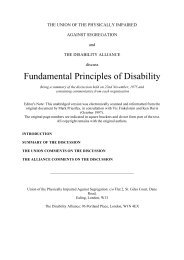Global-Report-Living-Colour-dr2-2
Global-Report-Living-Colour-dr2-2
Global-Report-Living-Colour-dr2-2
Create successful ePaper yourself
Turn your PDF publications into a flip-book with our unique Google optimized e-Paper software.
Inclusive Communities = Stronger Communities<br />
GLOBAL REPORT ON ARTICLE 19: THE RIGHT TO LIVE AND BE INCLUDED IN THE COMMUNITY<br />
77<br />
action plans that target people with disabilities do<br />
not routinely recognize those with intellectual<br />
disabilities in education, health and poverty<br />
reduction.<br />
‰ Medical Model of Disability<br />
Many of the services offered for people with<br />
intellectual disabilities, where there are services, are<br />
medically oriented and based on the medical model<br />
of disability which focuses on rehabilitation and<br />
interventions focused on fixing or preventing<br />
disability. International development assistance and<br />
investments through International Non-<br />
Governmental Organizations (INGOs) continue to be<br />
weighted towards vaccinations and programmes for<br />
“training” people with disabilities e.g. The Community<br />
Based Rehabilitation (CBR) model is implemented and<br />
delivered by professionals and centres around<br />
adaptations for the individual rather than the<br />
community. While the World Health Organization<br />
(WHO) is making efforts to adapt the CBR model<br />
towards a human rights approach, in its current<br />
application in communities it fails to address systemic<br />
discrimination such as the exclusionof children with<br />
intellectual disabilities from regular education, or<br />
access to regular employment at later ages.<br />
‰ Investment in Segregated Programmes<br />
The lack of any kind of service or support to enable<br />
participation in meaningful activities such as<br />
education or employment results in efforts to<br />
establish and invest in segregated programmes.<br />
Governments, family organizations, disabled peoples<br />
organizations, INGOs and international development<br />
assistance programmes continue to invest in<br />
segregated and isolating programmes.<br />
In Kenya, family support groups meet to learn about<br />
how to obtain the benefits government offers and to<br />
COLOMBIA There remains a paradigm<br />
about disability based on a medical<br />
model and low value of people with<br />
intellectual disabilities in our country.<br />
Parents continue to receive supportive<br />
care focused on deficit and weaknesses<br />
generating attitudes of protection, fear<br />
and fear of letting their children attend<br />
inclusive settings. The alternative for<br />
adult life remains sheltered institutions<br />
or artistic and cultural centres. We hope<br />
that this report will give us ideas on<br />
how to transform existing institutions<br />
that simply provide care in segregated<br />
places so that we can advance new<br />
ideas of life in the community.<br />
NEPAL “I was advised to take my<br />
son to physiotherapist. Regular<br />
physiotherapy was too expensive for<br />
my family. So I enrolled in a<br />
physiotherapy course through a<br />
distance learning programme. This<br />
allowed me to tend to my children,<br />
while gaining knowledge of<br />
physiotherapy. My experience, course<br />
work, and compassion for children with<br />
Down Syndrome led me to open a<br />
clinic in front of a renowned<br />
government hospital. The clinics<br />
proximity to the hospital allowed me to<br />
connect with other parents of children<br />
with Down Syndrome. In 2005, I<br />
registered and started Down’s<br />
Syndrome Association, Nepal – the<br />
first and only one of its kind in Nepal.



